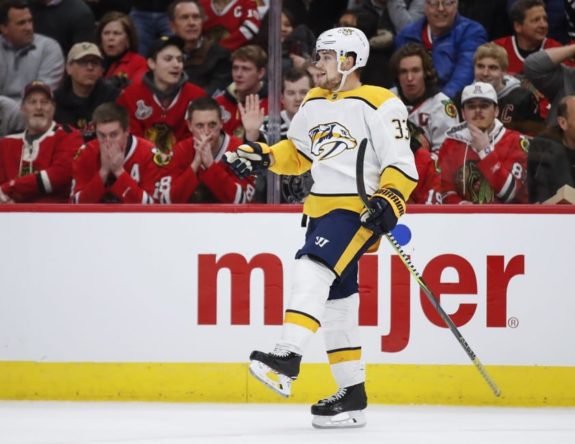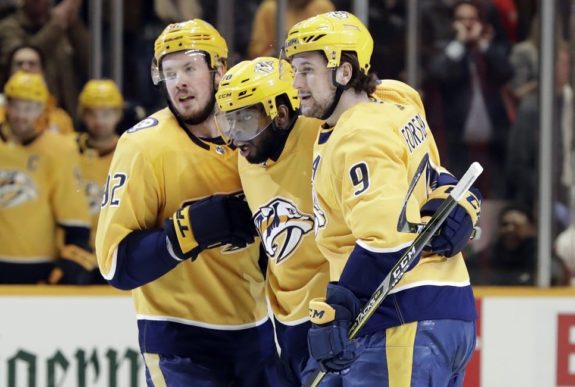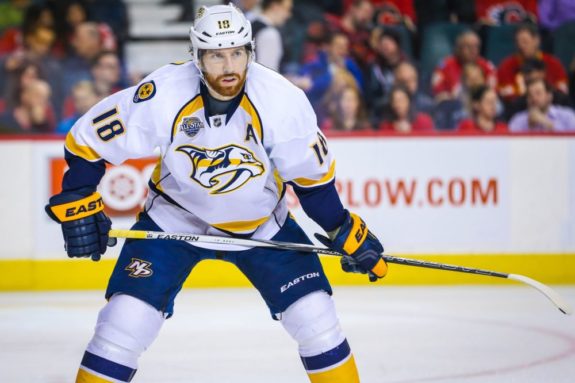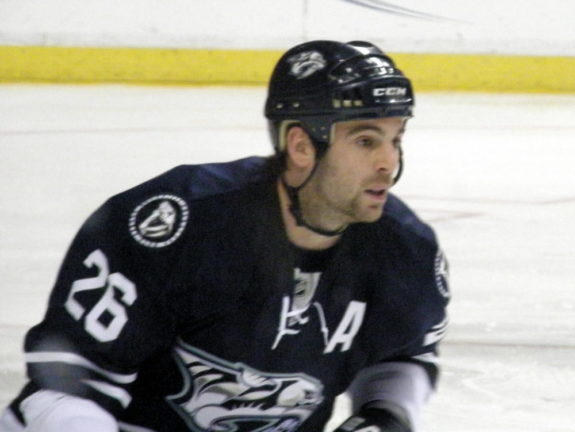The Nashville Predators have had a problem scoring goals in 2018-19. At the time of writing this, they are tied for 17th in goals-per-game with 2.94 thanks to shooting 8.9 percent as a team, 23rd in the league. They’ve scored three or fewer goals in 41 of their 69 games and have a 14-23-4 record in those games. Ryan Ellis, Filip Forsberg, Calle Järnkrok, Craig Smith, P.K. Subban and Kyle Turris are having down seasons relative to 2017-18 and it has hurt the team as a few players have carried the workload this season.
However, one Predator who isn’t having a down season and is carrying the team is 25-year-old Swedish winger Viktor Arvidsson. At 5-foot-9, he is often overlooked in discussions of the league’s best players, but he has emerged as one of the league’s best scoring threats in recent seasons, and he’s only gotten better in 2018-19. Although he missed significant time earlier in the season, he has been on a goal-scoring tear when healthy and is having one of the best seasons in franchise history.
Arvidsson’s 2018-19 Season
In 45 games this season, Arvidsson has 28 goals, 10 assists, one power-play goal, one shorthanded goal, a plus-one turnover margin and is averaging 19:18 of ice time per-game. Additionally, he’s been worth 5.2 goals above replacement and 0.9 wins above replacement, metrics that measure the number of goals and wins, respectively, that a player is worth relative to a replacement-level player, and 4.2 offensive point shares, which measures how many points a player’s offensive contributions have been worth to his team in the standings.

Setting Numerous Career Highs
Even with his season totals being hindered due to injuries, Arvidsson is still having a career season. His 26 even-strength goals are already the most of his career, having surpassed his 23 from last season. His shooting percentage (18.4 percent) is also a career high, nearly six points above the 12.6 percent he shot in 2016-17. Furthermore, his 19:18 of average ice time is over a minute more than the 17:45 he averaged in 2017-18 and he’s now had his ice time increase each of his five NHL seasons.
From a rate stat perspective, his .62 goals-per-game (G/G) and .84 points-per-game are also career highs and his points-per-game rate has increased each season. The same holds true for his 2.32 goals-per-60 and 3.12 points-per-60 at even strength. Lastly, his 12.1 even strength shots-per-60 are also a career high.
What’s interesting are his 10 assists, or .22 assists-per-game, both the lowest of his career for a full season. Both are the result of teammates being unable to capitalize on scoring chances, something that’s plagued the team all season. For example, the Predators’ shooting percentage when Arvidsson is on the ice is 10.3 percent in all situations and 10.3 percent at even strength. When he’s not on the ice, they drop to 8.9 percent and 8.8 percent, respectively.
With Ryan Johansen and Forsberg on the top line, it’s a similar situation. When the trio is together, the line shoots 10.3 percent in all situations and 10.5 percent at even strength. Without Arvidsson, Forsberg and Johansen shoot 8.1 percent in all situations and 7.8 percent at even strength.

Missed Time Hinders Possibilities
As I’ve alluded to twice now, Arvidsson missed significant playing time earlier this season. In total, he’s missed 24 games this season between two stints on injured reserve. He missed three games between Oct. 30 and Nov. 10 with a lower-body injury. He followed that up by suffering a broken thumb in his first game back and was held out of game action from Nov. 11 until Dec. 27.
Based on his .62 G/G rate, he would currently have 42 goals had he appeared in all 69 of the Predators games. That would put him second in the league behind Alex Ovechkin’s 46 goals. Furthermore, had he stayed healthy and been able to play a full 82-game schedule, he’d be on-pace to score 50 goals this season.
He has scored a goal in 21 of his 45 games (46.7 percent) and the Predators have a 15-4-2 record in those games. He also has six games (13.3 percent) in which he’s scored multiple goals and they’ve gone 4-1-1 in them. In the 24 games he hasn’t found the back of the net, the Predators barely have a winning record at 12-11-1.
Arvidsson’s Rank on Team & in the League
In the introduction I mentioned that Arvidsson is one of the few Predators who’ve had productive 2018-19 seasons. Therefore, it shouldn’t be surprising that he leads the the team in many categories.
|
Category |
Arvidsson’s 2018-19 Stat |
Rank on Predators |
| Goals | 28 | 1st |
| Points | 38 | 5th |
| Even-Strength Goals | 26 | 1st |
| Shooting Percentage | 18.4 | 1st |
| Time on Ice | 19:18 | 2nd among forwards |
| Offensive Point Shares | 4.2 | 2nd |
| Goals Above Replacement | 5.3 | 6th |
| Goals-Per-60 | 1.93 | 1st |
| Points-Per-60 | 2.62 | 1st |
| Even-Strength Goals-Per-60 | 2.32 | 1st |
| Even-Strength Points-Per-60 | 3.12 | 1st |
But Arvidsson’s also done well relative to the rest of the league in several categories:
|
Category |
Arvidsson’s 2018-19 Stat |
League Rank (minimum 500 even-strength minutes) |
| Even-Strength Goals | 26 | T-6th |
| Even-Strength Goals-Per-60 | 2.32 | 1st |
| Even-Strength Points-Per-60 | 3.12 | T-9th |
| Even-Strength Shots-Per-60 | 12.1 | 2nd |
So it’s clear that Arvidsson is having an excellent season relative to his teammates and the rest of the league and he would be among the league leaders in goals this season had he not missed so much time. However, despite his lengthy absence, he’s still having an all-time great season in franchise history.
Best Season in Predators History?
What’s surprising is that for a franchise that has been around for 20 seasons like the Predators have, they have yet to have a 50-goal scorer. By comparison, the current version of the Winnipeg Jets (formerly the Atlanta Thrashers) have two 50-goal seasons, both by Ilya Kovalchuk, in 2005-06 and 2007-08. But the Predators also don’t have a 40-goal scorer or even a 35-goal scorer, for that matter.
Instead, the most goals scored in a season in franchise history is 33. Jason Arnott reached that mark in 2008-09 and Forsberg did so in 2015-16. In fact, there have only been eight occurrences of a Predator scoring 30 or more goals in a season, which means that the 28 goals Arvidsson currently has already tie for 11th-most in a season. But what sets his season apart from those above him on the franchise’s leaderboard is that he’s reached his goal total in fewer games than anyone else and his .62 G/G are a franchise record, .11 above Arnott’s .51 for second.
So, with 13 games remaining in the regular season and Arvidsson needing five goals to tie Arnott and Forsberg’s record, he has a strong chance to set the franchise’s record for goals in a season despite playing in far fewer games. And that means he’s having the best season in franchise history, both from a total and rate stat standpoint. Let’s compare his 2018-19 season with those of the players ahead of him on the franchise goal leaderboard.

33 Goals – Jason Arnott, 2008-09
In 2008-09, Arnott, the team’s captain, netted 33 goals in his age-34 season to tie a career-high. His 33 goals were 10 more than Shea Weber in second place. He did so in 65 games for a .51 G/G average. He shot 16.8 percent and scored goals in 26 of his 65 games (40 percent). He had six games with multiple goals (9.2 percent).
33 Goals – Filip Forsberg, 2015-16
In 2015-16, Forsberg set a career high with 33 goals. He reached that total in 82 games for a .40 G/G average. He shot 13.4 percent and scored goals in 26 of 82 games (31.7 percent) and had multiple goals in five games (6.1 percent).
Related: Filip Forsberg Trade Revisited
31 Goals – James Neal, 2015-16
Also in 2015-16, James Neal tallied 31 goals for what remains the second-highest total of his career. He played a full 82-game schedule that season and averaged .38 G/G. He shot 11.6 percent and scored a goal in 25 games (30.5 percent) and two-plus goals in five games (6.1 percent).

31 Goals – Viktor Arvidsson, 2016-17
Arvidsson reached his current career high of 31 goals during the 2016-17 season. He played in 80 games that season for a .39 G/G average. He shot 12.6 percent, also his current career high, and netted a goal in 25 games (31.3 percent). He scored multiple goals in five games (6.3 percent).
31 Goals – Filip Forsberg, 2016-17
Forsberg scored 31 goals in 2016-17 for the second-highest total of his career and the only other time he’s reached the 30-goal mark. He and Arvidsson tied for the team-lead and finished eight goals ahead of Neal for second place. He played a full season and averaged .38 G/G. He shot 13.2 percent and had a goal in 25 games (30.5 percent) and two-plus goals in four games (4.9 percent)
31 Goals – Paul Kariya, 2005-06
In his first of two seasons in Nashville, Hall of Famer Paul Kariya eclipsed the 30-goal plateau for the seventh and final time in his illustrious career. He played in all 82 games for a .38 G/G average. He shot 12.7 percent and had a goal in 24 games (29.3 percent) and had multiple goals in six games (7.3 percent)
31 Goals – Steve Sullivan, 2005-06
The same season that Kariya netted 31 goals, Steve Sullivan tied that mark for the team-lead, six more than Scott Hartnell in second place. However, Sullivan did so in 69 games for a .45 G/G average. He shot 16.1 percent and scored in 25 games (36.2 percent) and had two-plus goals in five games (7.2 percent).

30 Goals – Patric Hornqvist, 2009-10
Current Pittsburgh Penguin Patric Hornqvist scored a career-high 30 goals in his second season. He paced the team in goals and had nine more than Martin Erat in second place. He played in 80 games for a goals-per-game average of .38. He shot 10.9 percent and had a goal in 25 games (31.3 percent) and had multiple goals in five games (6.3 percent).
29 Goals – J.P. Dumont, 2007-08
J.P. Dumont’s only season with at least 25 goals, he netted 29 of them in 2007-08. He finished with one goal more than Arnott in second place. He played in 80 games for a .36 G/G average. He shot 15.1 percent and had goals in 28 games (35 percent). He tallied multiple goals in a game once (1.3 percent).
29 Goals – Viktor Arvidsson, 2017-18
Arvidsson’s second time on this list, he finished with 29 goals last season. He had a three-goal lead over Forsberg to pace the team. He played in 78 games and averaged .37 G/G. He shot 11.7 percent, found the back of the net in 27 games (34.6 percent) and had two-plus goals in two games (2.6 percent).
All-Time Great Season
It’s clear that Arvidsson is having an excellent campaign. Not only is he on-pace to blow past current career highs, but he’s also having one of the best seasons in franchise history. If the season ended today, he’d already tie for the 11th-most goals in a season in franchise history. However, the season doesn’t end today.
Instead, he has 13 more games to tie or surpass the franchise high, and if he plays in every remaining regular-season game and maintains his current goal rate, he’ll finish with 35 goals. But not only is he on-pace to break the franchise’s goal record, he’s only one even-strength goal behind Neal’s 27 from 2015-16 to tie the club record in that category, as well.
On a team that has struggled to score this season, Arvidsson has been one of the few bright spots. He’s a main reason they’re currently in first place in the Central Division and is a top candidate to be the team’s MVP for 2018-19. He’s been a productive player for several seasons, so it’s great to see him finally earning the respect he’s long deserved.
*All stats came from Hockey-Reference and Natural Stat Trick